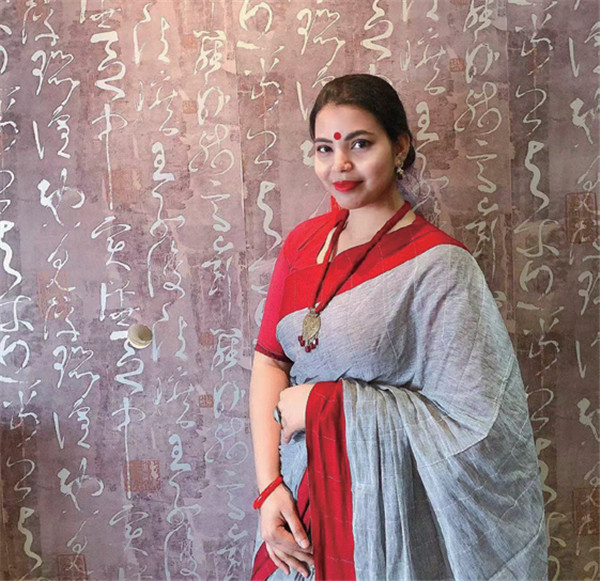我与中国的“茶之缘”
[ 孟加拉国 ] 妮鲁 贵州大学

两位仙气飘飘的茶艺师,在悠扬沉静的古琴声中,调息静心,行云流水般地展示着泡好一壶茶的艺术……观众们都沉浸在若隐若现的丝丝茶香之中,而我,也彻底沦陷在中国茶艺带来的视觉享受里,久久不能平静。
这就是我第一次真正意义上欣赏中国茶艺表演的场景,我想也是因为这次经历开启了我与中国的“茶之缘”。其实很早就听说,对中国人而言,日常生活最重要的七样东西是:柴、米、油、盐、酱、醋、茶,这前六样我倒是能明白,毕竟“民以食为天”,可是这“茶”到底为什么对中国人如此之重要呢?

妮鲁参加茶艺活动
在来中国之前,我也听我的导师说过,中国的茶有着悠久的历史,中国的茶文化源远流长。来到贵州大学以后,艾莎姐姐告诉我,作为一名汉语国际教育专业的硕士研究生,在这三年里我们会学到很多的中国传统才艺,其中就有中国茶艺。听到这个消息,让饮茶“小白”的我来说,欢呼雀跃。听说会有一个喜欢穿汉服和旗袍,特别有气质的、仙女般的老师来教我们茶艺,我当时就充满了期待。可是当我真正看到什么叫茶艺之后,我也逐渐开始明白,中国人之所以看重“茶”,这不只是一种饮品,也是一种生活,一种精神,更是一种文化。

贵州大学校园 / 妮鲁提供
后来就是期待已久的茶艺课了,坐在教室里的我,看着老师的一颦一笑,听着她轻柔的话语,关于茶的种种知识就这样不知不觉地进入我的脑海和心里。我开始从一个全新的角度去了解中国的茶文化,知道了不同茶的名字和产地,比如浙江的龙井、云南的普洱、武夷山的大红袍,还有我身在贵州,原来这里也有许多好茶,像都匀毛尖、湄潭翠芽都是这里老百姓的挚爱;我也了解到原来茶叶还有不同的制作工艺,采摘、晒青、做青、杀青等。但是真正吸引着我的还是中国茶艺,我也想像老师一样优雅、沉稳,并且“正确”地沏上一壶茶,致长辈,敬客人,给自己。

中国风光 / 妮鲁提供
我开始潜心向老师学习茶艺,逐渐掌握了生活茶艺和花茶茶艺,这才知道原来泡茶也有泡茶的艺术,茶叶的多少、茶具的选择、水的温度、泡茶的手势,甚至品茶的时间都影响着茶的味道。为了让看我泡茶的人有最好的享受,我还学了怎么拿好杯子,泡茶的时候应该怎么坐,而手又应该放在哪里……慢慢地,我终于开始了解,为什么老师告诉我泡茶是一门艺术,也是一门学问,更是一种哲学。每个人泡茶方式不一样,看一个人泡茶,喝一个人泡的茶,你其实可以感受他的心情如何,他的性格又怎样。这简直太不可思议了,难怪古往今来,这么多诗词文学作品都谈论到茶。几千年的沉淀注定了“茶文化”之深厚,而我,像一条小鱼畅游于中国的茶海,自由且欢畅,越了解越好奇,越好奇越探索。我的朋友们经常问我:“妮鲁,你为什么那么喜欢中国茶呢?你怎么可以把中国茶泡得那么好?”我想,原因其实既直接又简单,就是因为爱吧!因为我爱中国茶,我也爱中国!爱中国的文化,爱我在中国遇到的这些可爱的人,爱中国教给我可以陪伴我一生的东西。

贵州大学新区校门 / 妮鲁提供
仔细想想,其实每个中国人不都很好地诠释着中国茶文化吗?你看,多少中国人开始一天工作之前泡上一壶茶,陪自己开始一天的奋斗;又有多少中国人,休憩之时,倒上一杯茶,捧一本书,自斟自饮;又有多少中国人叫上三五好友,以茶会友,聊尽生活的甘苦……就像茶一样,不用计较好茶、坏茶,只要合适的水温、合适的茶具、合适的环境,这就是中国人的情趣。那什么是合适?可能自己觉得合适就是合适吧。再联想到2020年1月的新冠肺炎疫情,多少中国人被困家中,没有怨声载道,没有心急如焚,而可能只是和家人一起泡一壶浓茶,关心着疫情的发展,闻一闻热茶的香气,静静地等待春暖花开,这难道不是茶的哲学,不是中国人的哲学吗?

贵州大学阅湖与图书馆 / 妮鲁提供
我很幸运,能够在中国与茶邂逅,了解茶,学习茶,爱上茶。老师告诉我,茶有三品:一品感恩,二品知足,三品惜福。我愿带着茶的馨香、茶的文化、茶的哲学,将我与中国的“茶之缘”分享给更多想要了解中国茶的外国人,借用中国诗人白居易的诗句,“无由持一碗,寄与爱茶人”,愿爱中国茶的你我、和中国结下茶缘的你我一起,以茶修身,茶悦人生!
My Love Knot of Chinese Tea
[Bangladesh] Akter Nilu, Guizhou University
Under the melodious and placid music of guqin, a seven-stringed plucked Chinese instrument, two tea art masters with fairy spirit demonstrated how to make a pot of tea. Their performance is like floating clouds and flowing waters. With regulated breath and cleared mind, the audience were immersed in the faint fragrance of tea. I had completely fallen into the visual enjoyment brought by Chinese tea art and it was long time before I calmed down.
This was the first time I watched the Chinese tea art performance in its true sense. I think it was also this experience that started the “love knot” between China and me. In fact, I was told long time ago that for Chinese people, the seven most important things in daily life are firewood, rice, oil, salt, sauce, vinegar and tea. I can understand the first six items. After all, as an old Chinese saying says, “food is the most important thing for the people.” But why is the “tea” so important too?
Before coming to China, my tutor told me that Chinese tea has a long history and so does its culture. After being in Guizhou University, sister Ai Sha told me that as postgraduate students majoring in Chinese language teaching, we would learn a lot of traditional Chinese skills in three years, including tea art performance. As a beginner, I was very excited to hear this. I heard that there would be a fairy-like teacher who liked to wear Hanfu, or cheongsam, to teach us tea art. I was filled with anticipation at that time. But when I really saw what the tea art is, I gradually began to understand why Chinese people value “tea” so much. It is not just a drink, but a life style, spirit and culture.
Then came the long-awaited tea art class. Sitting in the classroom, I looked at the teacher’s smile and listened to her gentle words. All kinds of knowledge about tea came into my mind unconsciously. I began to understand China’s tea culture from a new perspective and learned the names and origins of different teas, such as Longjing in Zhejiang Province, Pu’er in Yunnan Province, Dahongpao in Wuyi Mountain. I was in Guizhou and it turned out that there are so many good teas here, such as Duyun Maojian and Meitan Cuiya, which are the favorites of local people. I also learned that there are different processing techniques for tea making, such as picking, drying, processing, fixation and so on. However, what really attracts me is the Chinese tea art performance. I also want to be as elegant and calm as the tea master, who can brew a pot of tea “in a right way” and serve them to the elders, the guests and herself.
I started to immerse myself into the tea art performance from the teacher and distinguished the difference between everyday tea drinking and the art of making tea. Only then did I realize that tea making is kind of art too. The amount of tea leaves, the choice of tea sets, the temperature of water, the movement of hands, and even the time of making tea will affect the taste of tea. I also learned how to hold the tea cup properly, how to sit while making tea and where to put my hands in order to give the best enjoyment to those watching me to make tea. I finally understand why the master told me that tea drinking is not only an art, but also a science and philosophy. Everyone makes tea in his own way. By watching a person make tea and drinking the tea he made, you can actually feel his mood and know his personality. It’s so incredible. No wonder so many poems and literary works through the ages tackled tea. Thousands of years of accumulation are bound to have the profound “tea culture”. I, like a small fish in the sea of Chinese tea, am swimming freely and happily. The more I understand, the more curious I am, and the more I explore. My friends often asked me, “Niru, why do you like Chinese tea so much ? How can you make Chinese tea so well?” I think the reason is direct and simple. It is because of love – I love Chinese tea. I love China and the culture of China. I love the warm people I met in China. The things I learned in China can accompany me for my whole life.
Ponder it carefully. Isn’t everyone in China a good interpreter of Chinese tea culture? There are so many Chinese people who choose to make a pot of tea before starting their daily work. The tea is a good company for their arduous job. Many Chinese people pour a cup of tea and read a book during their break time; and many Chinese people have a tea party with friends to share the joy and hardships of life… Just like tea, no matter it is good or bad, with the right water temperature, the right tea set and the right environment, everything will be right. This is the taste of Chinese people. So what is right? Possibly what you think right is right. During the COVID-19 pandemic starting from January 2020, many Chinese people were trapped at home but had no complaining and worrying. They may make a pot of strong tea and stay with family members. They did have concerns about the evolution of the epidemic but meanwhile they enjoyed the aroma of hot tea. They quietly waited as they believed that the spring would come and the flowers would bloom. Isn’t that the philosophy of tea, the philosophy of Chinese people?
I was very lucky to encounter tea in China, where I understand tea, study tea and love tea. Teachers told me that the tea can be tasted with three levels. The first is gratitude, the second contentment and the third happiness. I am willing to share “my love knot of Chinese tea,” including the fragrance, the culture and the philosophy of tea, with more foreigners who have interest in learning about Chinese tea. I would like to quote the poem of Bai Juyi, a famous Chinese poet, “There is no reason to hold a bowl of tea, which contains my deep feeling to the tea lovers.” I wish you and me, who love Chinese tea and set up the bond with China, unite together to cultivate ourselves with tea and enjoy life with tea!



